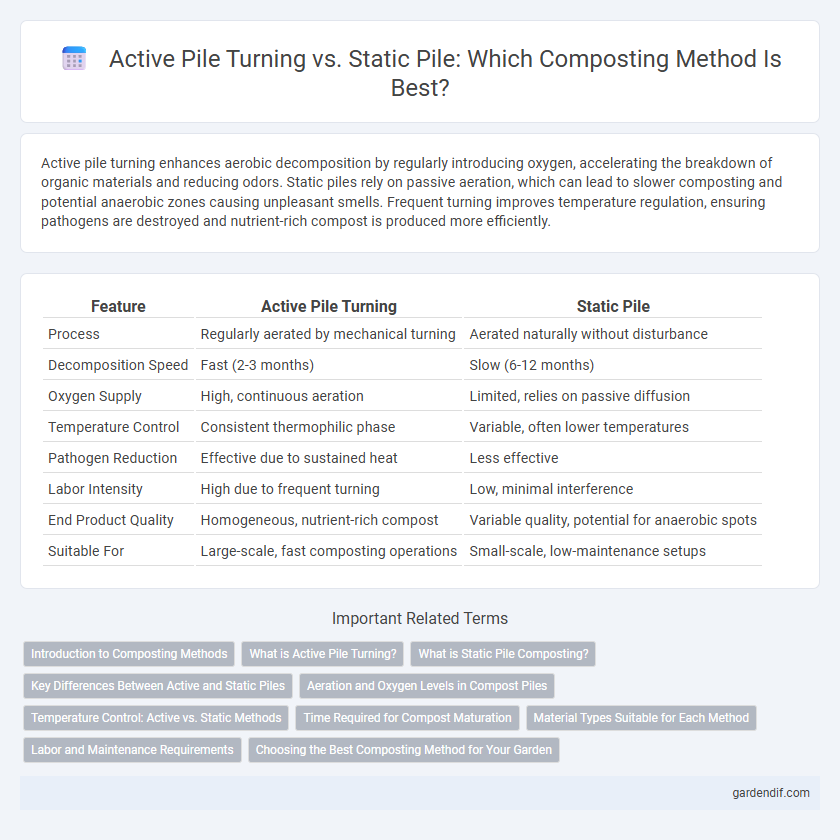
Active Pile Turning vs Static Pile Illustration
Active pile turning enhances aerobic decomposition by regularly introducing oxygen, accelerating the breakdown of organic materials and reducing odors. Static piles rely on passive aeration, which can lead to slower composting and potential anaerobic zones causing unpleasant smells. Frequent turning improves temperature regulation, ensuring pathogens are destroyed and nutrient-rich compost is produced more efficiently.
Table of Comparison
| Feature | Active Pile Turning | Static Pile |
|---|---|---|
| Process | Regularly aerated by mechanical turning | Aerated naturally without disturbance |
| Decomposition Speed | Fast (2-3 months) | Slow (6-12 months) |
| Oxygen Supply | High, continuous aeration | Limited, relies on passive diffusion |
| Temperature Control | Consistent thermophilic phase | Variable, often lower temperatures |
| Pathogen Reduction | Effective due to sustained heat | Less effective |
| Labor Intensity | High due to frequent turning | Low, minimal interference |
| End Product Quality | Homogeneous, nutrient-rich compost | Variable quality, potential for anaerobic spots |
| Suitable For | Large-scale, fast composting operations | Small-scale, low-maintenance setups |
Introduction to Composting Methods
Active pile turning enhances aerobic decomposition by regularly aerating the compost, accelerating microbial activity and heat generation. Static pile composting relies on passive aeration and requires longer decomposition times due to limited oxygen flow. Choosing between these methods depends on factors like compost volume, desired processing speed, and resource availability.
What is Active Pile Turning?
Active pile turning is a composting method that involves regularly aerating and mixing organic material to accelerate decomposition and maintain optimal oxygen levels. This process enhances microbial activity, reduces odor, and promotes faster breakdown compared to static pile composting. By manually or mechanically turning the pile, temperatures are evenly distributed, ensuring efficient pathogen destruction and nutrient retention.
What is Static Pile Composting?
Static pile composting is a method where organic materials are accumulated in a single mound without regular turning, allowing natural microbial activity to break down waste over time. This process relies on passive aeration through the pile's natural porosity, which can result in slower decomposition compared to active pile turning. Static piles are often covered to maintain moisture levels and temperature, promoting aerobic conditions essential for effective composting.
Key Differences Between Active and Static Piles
Active pile turning involves regular aeration and mixing of compost to accelerate microbial activity, resulting in faster decomposition and higher temperature control. Static piles remain undisturbed, relying on passive aeration which can lead to slower composting rates and uneven temperature distribution. Key differences include oxygen availability, temperature regulation, and composting time efficiency, making active turning suitable for larger-scale operations seeking rapid results.
Aeration and Oxygen Levels in Compost Piles
Active pile turning significantly enhances aeration by mechanically disrupting the compost mass, ensuring uniform oxygen distribution crucial for microbial activity and faster decomposition. In contrast, static piles rely on passive aeration, often resulting in lower oxygen levels and potential anaerobic zones that slow down the composting process. Maintaining optimal oxygen concentrations around 5-15% through active turning prevents foul odors and promotes efficient organic matter breakdown.
Temperature Control: Active vs. Static Methods
Active pile turning enhances temperature control in compost by regularly aerating and mixing materials, promoting uniform microbial heat generation and preventing anaerobic zones. Static pile methods rely on passive aeration, often resulting in uneven temperature distribution and potential cold spots within the compost mass. Maintaining optimal composting temperatures between 130degF and 160degF is more consistently achievable with active pile turning, accelerating organic matter decomposition and pathogen reduction.
Time Required for Compost Maturation
Active pile turning accelerates compost maturation by enhancing aeration and microbial activity, often reducing the time required to 4-8 weeks. In contrast, static pile composting relies on passive aeration, resulting in longer maturation periods ranging from 3 to 6 months. Efficient oxygen distribution and moisture control in actively turned piles optimize decomposition rates, making them preferable for faster compost production.
Material Types Suitable for Each Method
Active pile turning is ideal for organic materials with high moisture content and coarse texture, such as yard waste, food scraps, and manure, as it promotes aeration and faster decomposition. Static piles suit finer, more homogeneous materials like shredded leaves, sawdust, and paper, which retain structure and moisture without frequent disturbance. Selecting the appropriate pile method based on material type enhances microbial activity and optimizes compost quality.
Labor and Maintenance Requirements
Active pile turning in composting demands higher labor input for frequent aeration and moisture control, ensuring rapid decomposition and odor management. Static piles require less labor and maintenance due to minimal disturbance but may experience slower microbial activity and uneven composting. Efficient labor allocation influences overall compost quality and operational costs in both methods.
Choosing the Best Composting Method for Your Garden
Active pile turning accelerates composting by regularly aerating organic material, promoting faster microbial activity and reducing odor. In contrast, static pile composting requires less labor but decomposes more slowly due to limited oxygen diffusion. Gardeners seeking rapid nutrient-rich compost should opt for active pile turning, while those preferring low-maintenance methods may choose static piles.
Active Pile Turning vs Static Pile Infographic

 gardendif.com
gardendif.com